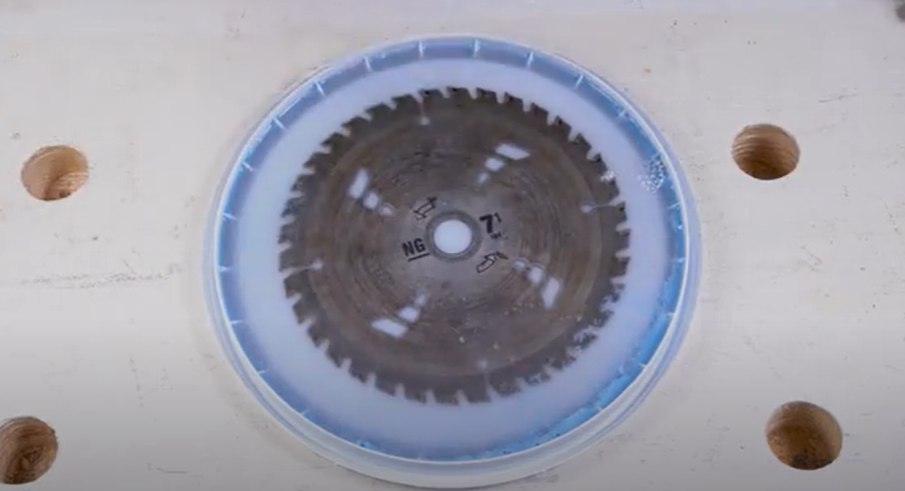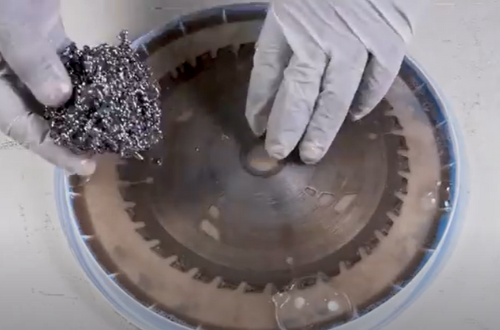As someone who has spent years working with saws and blades, I’ve seen firsthand how resin and pitch build-up can harm your tools. This sticky residue doesn’t just make cutting harder—it dulls the blade, causes overheating, and, if ignored, can even lead to blade failure.
I’ve often noticed that used blades don’t perform like new ones. It’s a common issue that can be easily fixed. Through my experience, I’ve learned that cleaning your blade after every 20–30 uses restores its sharpness, improves cutting precision, and adds years to its lifespan.
Drawing from my hands-on expertise, I’ve put together a simple, step-by-step guide to help you clean resin and pitch from your circular saw blades. These tips are designed to make the process easy and effective for anyone.
When do you feel the blade needs to be cleaned?
Signs Your Blade Needs Cleaning:
- Reduced Efficiency: Struggles to cut smoothly or leaves rough edges.
- Excessive Heat: Overheating caused by clogged teeth.
- Smoke or Burning Smell: Indicating friction from a dirty blade.
- Visible Build-Up: Resin, pitch, or sawdust stuck on the blade.
Regular cleaning enhances performance and prolongs the blade’s lifespan.
What You’ll Need
Before you begin, gather the following materials:
- A plastic container or shallow pan
- Blade cleaner (commercial solution or DIY options like diluted ammonia or baking soda)
- A soft nylon brush or toothbrush
- Clean water
- Lint-free cloth or paper towels
- Rubber gloves (optional for protection)
Step-by-Step Cleaning Guide
1. Remove the Blade
Unplug your saw or remove the battery to ensure safety. Carefully detach the blade from the saw using the manufacturer’s instructions.
2. Prepare the Cleaning Solution

Fill a plastic container with your chosen cleaning solution:
DIY Options: To dissolve resin and pitch, a mix of warm water with a small amount of household ammonia or baking soda works well.
Commercial Blade Cleaner: Designed specifically for cutting tools, these cleaners are highly effective.
3. Soak the Blade

Place the blade in the solution, ensuring it is fully submerged. Allow it to soak for about 15–30 minutes. This loosens the resin and pitch, making them easier to remove.
4. Scrub the Blade

Using a soft nylon brush or toothbrush, gently scrub along the teeth and flat surfaces of the blade. Pay extra attention to the gullets (the curved areas between the teeth) where buildup tends to accumulate.
5. Rinse and Dry

Rinse the blade rigorously with clean water to remove any remaining cleaner or debris. Dry the blade immediately with a lint-free cloth or paper towel to prevent rusting.
6. Reinstall the Blade
Once the blade is clean and dry, reinstall it onto your saw. Double-check that it’s securely fastened and properly aligned.
Additional Tips:
- For stubborn resin, you can soak the blade in a mixture of warm water and a degreaser for a few hours.
- Avoid using harsh chemicals or abrasive cleaners that can damage the blade’s surface.
- Clean your saw blade regularly to prevent excessive build-up and maintain optimal performance.
- Consider using a blade cleaner specifically designed for removing resin and pitch.
Remember:
- Always follow the manufacturer’s instructions for your specific saw blade.
- If the blade is severely damaged or worn, it’s best to replace it rather than attempt to repair it.
By following these steps and tips, you can keep your circular saw blades clean and in top working condition, ensuring smooth and efficient cuts every time.
The Benefits of Cleaning Saw Blades:
Over the years, I’ve seen firsthand how keeping saw blades clean can make all the difference in your work. Here’s why regular cleaning is essential:
- Improved Cutting Performance
Resin and pitch buildup can dull your blade, slowing you down and ruining your cuts. By cleaning the blade, you restore its sharpness and get clean, precise results every time. - Extended Blade Lifespan
A well-maintained blade lasts much longer. When you remove debris and prevent rust, you avoid costly replacements. Trust me, it’s worth the few extra minutes. - Reduced Risk of Accidents
Dull blades are dangerous. They can cause kickbacks and other problems that no one wants to deal with. A clean blade stays sharp and reduces these risks, keeping you safe on the job. - Smoother Operation
A clean blade runs smoother, with less vibration and noise. You’ll notice the difference immediately. It makes every cut feel effortless and keeps the work enjoyable. - Enhanced Accuracy
Clean blades give you more precise cuts. Whether you’re working on a tight project or cutting expensive material, accuracy is everything.
Cleaning your saw blades isn’t just about maintenance—it’s about getting the best results and staying safe. After decades in construction, I’ve learned that a little care goes a long way.
Recommendations from popular blade manufacturers

Here are some examples of recommendations from popular blade manufacturers for cleaning circular saw blades:
1. Freud Tools
Freud recommends using their specially formulated Blade & Bit Cleaner, which is designed to safely dissolve resin and pitch without harming the blade’s non-stick coating or carbide tips. They advise against using harsh abrasives or metal scrapers to avoid damaging the precision-ground teeth.
2. Diablo Tools
Diablo suggests using their Non-Stick Coating Maintenance Tips, emphasizing gentle cleaning with nylon brushes and approved cleaning solutions. They also recommend avoiding prolonged exposure to water and drying the blade thoroughly to prevent corrosion.
3. DeWalt
DeWalt encourages users to inspect blades after heavy use and clean them as soon as pitch buildup is visible. They recommend soaking the blade in a mild cleaning solution and using soft brushes for scrubbing. DeWalt also stresses the importance of drying the blade completely and applying a protective coating if storing it for long periods.
4. Bosch
Bosch advises cleaning blades regularly with warm, soapy water or a dedicated blade cleaner to remove resin and sap. They discourage the use of strong chemicals, as these can degrade the blade’s finish. Bosch also highlights the importance of checking the blade for damage during cleaning.
5. Makita
Makita recommends their Saw Blade Maintenance Program, which includes cleaning with a gentle degreaser or a blade-specific cleaning agent. They warn users to avoid applying excessive force on the carbide tips during scrubbing to prevent chipping.
6. Milwaukee Tool
Milwaukee suggests using an eco-friendly cleaner for removing pitch and debris. They advise against submerging blades for extended periods, as this can damage coatings. Instead, they recommend a quick soak and immediate drying.
Conclusion
Over my years in construction, I’ve learned that cleaning resin and pitch from circular saw blades is essential for keeping them in best shape. A clean blade cuts smoother, lasts longer, and operates more safely by reducing the risk of overheating and kickbacks.
By following the simple steps I’ve outlined and sticking to the manufacturer’s guidelines, you can keep your blades performing like new with very little effort. It’s a small task that makes a big difference in how your tools work.
Taking care of your blades not only saves money on replacements but also gives you cleaner, more precise results on every project. A well-maintained blade is a reliable blade, so don’t skip this important part of tool care. Trust me, your saw—and your projects—will thank you.
FAQ
Here’s what I’ve learned from my years of experience working with saws and blades:
- How do you remove pitch and resin from saw blades?
First, detach the blade to work safely. Soak it in warm water mixed with a blade-cleaning solution or mild degreaser. Then scrub the teeth and surfaces with a soft-bristle brush. Rinse the blade thoroughly and dry it right away to prevent rust. - Why is cleaning resin and pitch from saw blades important?
When resin and pitch build up, they dull the blade and make cuts uneven. This puts extra tightness on the motor and can lead to overheating or damage. Cleaning keeps the blade sharp, extends its life, and helps prevent accidents caused by dull or clogged teeth. - What is the best way to clean a circular saw blade?
I’ve found the best method is to soak the blade in a blade-cleaning solution or soapy water for 15–30 minutes. Scrub it delicate with a soft brush, rinse, and dry it completely. For extra care, apply a rust inhibitor before reinstalling. - What cleans the pitch off of saw blades?
Specialized blade cleaners work best, but household options like baking soda solutions, ammonia-based cleaners, or even oven cleaner can also do the job. Just follow safety guidelines when using any chemical cleaner. - How do you clean pitch from a blade?
Soak the blade in a cleaning solution designed to dissolve resin. Scrub the buildup with a soft brush, rinse thoroughly, and dry the blade to prevent rust. - How do you remove resin from wood?
To remove resin from wood, apply mineral spirits or rubbing alcohol to the area and scrub gently with a cloth. If it’s stubborn, lightly sand with fine-grit sandpaper. Finish by wiping clean and reapplying any protective coating. - Can I clean the blade without removing it from the saw?
Yes, but be extra cautious. Unplug the saw or remove the battery. Use a rag to clean the blade with a cleaning solution, rotating the blade by hand to clean all the teeth. - What’s the best way to prevent resin and pitch buildup?
Use sharp, high-quality blades suited to your material. Applying a non-stick blade lubricant before cutting can help. Avoid cutting wet or resin-heavy wood when possible, and clean the blade regularly. - Are there specialized products for cleaning saw blades?
Absolutely! Products like CMT Formula 2050 or Simple Green Industrial Cleaner are great options. They dissolve resin and pitch effectively without harming the blade and are safe for frequent use. - Can I use a power tool to clean the blade?
Yes, you can use a rotary tool with a nylon or brass brush attachment, but do so carefully. Use the tool on low speed to avoid damaging the teeth or overheating the blade.
If you follow these tips, your blades will stay sharp, safe, and ready for the next job!

